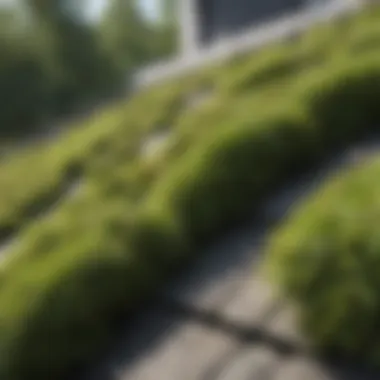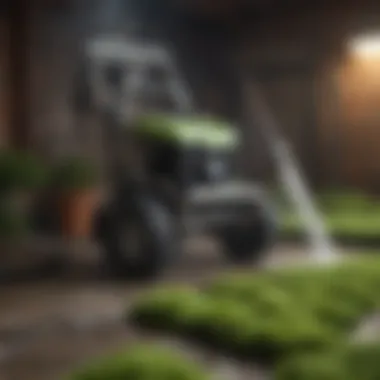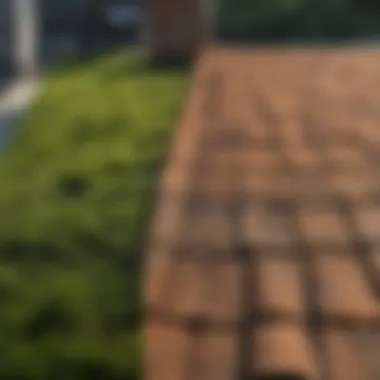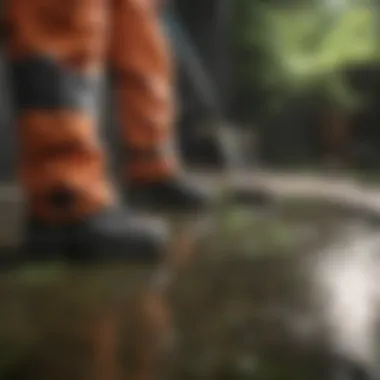Effective Moss Removal: Pressure Washing Your Roof


Intro
Moss on rooftops is not just an aesthetic issue; it poses potential damage to your home's structure. Homeowners often seek effective solutions to this problem. Pressure washing emerges as a common method, but it brings both advantages and risks. Understanding how to approach this task is crucial for maintaining your roof's integrity and longevity.
This article serves as a definitive guide for anyone considering pressure washing moss off their roof. By exploring the effectiveness, risks, and alternative solutions, readers will grasp the best practices for this maintenance chore. Furthermore, safety protocols and strategies to prevent moss recurrence will also be discussed, providing a holistic view of roof care.
Prelude to Moss on Roofs
Moss may seem like a benign plant, but its presence on roofs signals a series of potential issues. Understanding how moss grows and the types that commonly inhabit roofs is essential for homeowners. Regular maintenance not only preserves a home's aesthetic but also ensures its structural integrity. This article discusses the relevance of addressing moss on roofs with a particular focus on pressure washing as one effective method of removal.
Households must acknowledge that ignoring moss can lead to increased maintenance costs and shorter roof lifespan. Homeowners should be proactive rather than reactive when it comes to this green invader.
Understanding Moss Growth
Moss thrives in damp and shaded environments. This small, non-flowering plant often finds ideal conditions on roofs, particularly in areas that do not receive adequate sunlight. When moisture accumulates, moss quickly establishes itself, growing without requiring much soil or nutrients. The spores of moss get carried by wind and water, easily attracting to rooftops.
Factors contributing to its growth often include poor drainage, overhanging tree branches, and insufficient sun exposure. Homeowners should be vigilant in watching for any signs of moss, as it can spread quickly. Addressing its presence promptly can save extensive damage to roofing materials.
Common Types of Moss Affecting Roofs
There are several species of moss that typically affect roofs. The most prevalent include:
- Cushion moss (Dicranum) - This type tends to grow in dense cushions and can hold significant moisture.
- Haircap moss (Polytrichum) - Recognizable by its upright growth, it can often be found on steeper slopes of roofs.
- Sheet moss (Hypnum) - It lays flat and can create a thick mat across roof surfaces, impacting drainage.
Each of these varieties can create unique challenges when it comes to removal. Recognizing which type of moss is present can greatly influence the approach used for effective removal.
Homeowners need to regularly inspect their roofs and take action early rather than waiting for moss to establish itself. This proactive attitude will greatly facilitate future maintenance efforts.
The Implications of Moss on Roofs
Moss growing on roofs might seem like just a cosmetic issue. However, its presence can significantly affect the integrity of roofing structures. This section explores the implications of having moss on roofs, detailing how it impacts longevity and contributes to potential water damage risks. Understanding these factors is crucial for homeowners looking to maintain their property and protect their investment.
Impact on Roof Longevity
Moss can cause considerable wear on roofing materials over time. When moss accumulates, it often traps moisture against the roof surface. This constant moisture can lead to the deterioration of shingles, tiles, or other roofing materials. For asphalt shingles, the granules may erode faster, reducing their effectiveness at protecting against the elements.
Furthermore, certain types of roofs, such as wood shakes, are particularly susceptible. The moisture retained by moss promotes rot and infestation, which can lead to structural damage. This can necessitate costly repairs or even a full replacement of the roof.
- Moss retention of moisture: Directly contributes to accelerated deterioration.
- Reduced roofing life: Homeowners may find their roofs requiring replacement much sooner than expected.
Regular cleaning and maintenance can help mitigate these effects. Taking proactive measures will save homeowner money and prolong the life of the roof.
Potential Water Damage Risks
Water damage is one of the most significant risks associated with moss on roofs. As moss retains moisture, it can create an environment conducive to leaks and other water-related issues. When water seeps through roofing materials, it often leads to issues such as:
- Leaky Ceilings: Damage to the interior space, including walls and ceilings.
- Mold Growth: Increased moisture can lead to mold, which poses health risks and requires costly remediation.
- Foundation Problems: If water drains poorly due to moss-covered roofs, it may lead to foundation issues over time.
To prevent these risks, homeowners must regularly monitor their roofs for signs of moss and take timely action.
Understanding these implications stresses the importance of being vigilant about roof maintenance. Not only does moss threaten the physical structure, but it also poses substantial financial risks that could affect the overall safety of the home.


Methods for Removing Moss
Moss on roofs is not just an aesthetic problem. It poses various risks to the roofing material and the overall structural integrity of a building. Addressing this issue promptly and effectively is essential. This section will examine different methods for removing moss, highlighting their benefits and important considerations.
Overview of Removal Techniques
Removing moss from roofs is a multi-faceted task that may require various techniques. Homeowners should assess their specific situation before deciding on a method. Here are some common techniques:
- Pressure Washing: This method involves using a high-powered water spray to dislodge moss from the roof surface. It is often favored for its speed and effectiveness. However, caution is needed to avoid damaging roofing materials.
- Manual Removal: This traditional approach requires physical effort to scrape off moss. While labor-intensive, it can be less damaging to the roof. Tools like soft-bristled brushes or scrapers can be used effectively.
- Chemical Treatments: Various chemical solutions can effectively kill moss and prevent regrowth. These products are often applied as sprays. When choosing this method, it is essential to consider the potential environmental impact and compatibility with roofing materials.
"Choosing the right moss removal technique can prolong the life of your roof."
Each technique comes with its own set of advantages and disadvantages. Careful consideration of these factors will lead to a more informed decision.
Chemical Treatments vs. Mechanical Methods
When considering how to remove moss, homeowners typically weigh the pros and cons of chemical treatments in comparison to mechanical methods.
Chemical Treatments
- Effectiveness: Many chemical treatments are specially formulated to target moss. Products usually contain ingredients like sodium hypochlorite or potassium soap. These chemicals penetrate the moss and kill it effectively.
- Ease of Use: Applying chemical solutions requires less physical effort than manual removal. A simple spray can often suffice.
- Longevity: Some chemical treatments come with long-lasting effects, preventing regrowth for months.
- Environmental Concerns: Because chemical solutions may harm surrounding plants and wildlife, careful application is crucial to minimize potential negative impacts.
Mechanical Methods
- Control: Manual removal allows homeowners to control the process more closely. It helps avoid over-aggressive actions that can damage fragile roofing materials.
- No Chemical Risk: By removing moss manually, there is no risk of introducing harsh chemicals into the surrounding environment, which can be particularly important for eco-conscious homeowners.
- Time-Consuming: This method can require significant effort, especially for large areas. It is important for individuals to consider their physical capabilities.
Can You Pressure Wash Moss Off a Roof?
In the context of maintaining a roof's integrity, the method of removing moss is significant for homeowners. The question of whether pressure washing is suitable for moss removal is central to understanding both the benefits and risks involved in this cleaning technique. Using high-pressure water jets can be an effective way to eliminate moss, but it is not without its drawbacks.
Effectiveness of Pressure Washing
Pressure washing can yield immediate results in revealing clean roofing materials. The force of the water is capable of dislodging moss effectively, especially when it has formed thick layers. When considering effectiveness, several factors come into play, such as:
- Type of Moss: Different moss species have varying levels of adhesion to surfaces.
- Pressure Settings: The strength of the pressure washer can make a difference. It's crucial to choose a setting that is strong enough to remove moss without damaging shingle surfaces.
- Temperature of Water: Warmer water can enhance cleaning power, especially in killing spores and deterring future growth.
Many homeowners may observe significant results after a single session of pressure washing, making this option appealing. However, it should be understood that this method may not kill the underlying moss or spores completely. Regular follow-up treatments or additional methods might still be necessary to achieve long-term results.
Risks of Using Pressure Washers
Despite the potential benefits, pressure washing comes with risks that homeowners should carefully consider. First, using a pressure washer can lead to damage if not utilized properly. High-pressure water can:
- Dislodge Shingles: Excessive pressure can cause shingles to lift or crack, leading to leaks.
- Force Water Under Shingles: This can create gaps for water to enter, promoting mold or rot in roofing materials.
- Strain Yourself: Operating heavy machinery can cause physical stress, particularly if one is not accustomed to it.
"Proper technique and caution are essential when pressure washing roofs to avoid catastrophic damage to the materials."
Understanding Pressure Washing
Pressure washing is an essential topic when addressing moss removal from roofs. It involves using high-pressure water jets to clean surfaces effectively. Understanding pressure washing will help homeowners grasp its significance, its benefits, and the considerations they should keep in mind.
The primary justification for considering pressure washing is efficiency. Traditional cleaning methods can often be time-consuming and may not yield the desired results. With pressure washing, most types of grime and moss can be eliminated swiftly and thoroughly, saving valuable time and labor.
However, it’s vital to recognize that not all roofs are suited for this technique. Different roofing materials react differently to high-pressure water. For example, asphalt shingles might become damaged if the pressure is too high, while tile roofs may handle it better. Therefore,


- Knowledge of roofing types is crucial.
- Customizing pressure settings based on the material is necessary.
- Consulting with professionals can provide an additional layer of assurance.
Here, we introduce an important aspect of pressure washing: safety. Each homeowner must understand the safety precautions that should be in place when conducting a pressure wash. High-pressure streams can be dangerous if not handled correctly. Moreover, ensuring everyone's safety during the process can prevent accidents, and protect both individuals and property.
How Pressure Washing Works
Pressure washing operates by forcing water through a nozzle at significantly high pressures. The pressure can typically range from a few hundred to several thousand psi (pounds per square inch). This force is combined with water gallons per minute, which determines how effectively dirt, mildew, and moss are cleared from surfaces. A machine with adjustable pressure settings allows users to manage the force based on their cleaning needs.
The basic components include a high-pressure hose, a motor (which can be gas or electric), and different nozzle types to control the water stream. Varied spray patterns can aid in tackling different areas, maximizing cleaning effects without extensive manual scrubbing.
Types of Pressure Washers
There are several types of pressure washers available, each designed for specific applications:
- Electric Pressure Washers:
- Gas Pressure Washers:
- Commercial Pressure Washers:
- Suitable for lighter jobs and often found in residential homes.
- Quieter and more user-friendly than gas models.
- Ideal for moss removal from roofs requiring moderate pressure.
- More powerful and better suited for tough cleaning tasks.
- Suitable for larger areas and heavier build-up of moss and grime.
- Generally portable, offering more flexibility in usage.
- Designed for high-frequency users and larger projects.
- Durable and often more powerful.
- Essential for professionals or homeowners with extensive roofing.
Choosing the right type of pressure washer can optimize the moss removal process, making the task more effective and safer for the roof's longevity.
Best Practices for Pressure Washing Roofs
Using pressure washing methods to remove moss from roofs warrants careful planning and execution. This approach can effectively rid the surface of unwanted growth, but it needs to be carried out properly to avoid damaging the roof. Understanding best practices ensures the longevity of the roofing materials while achieving satisfactory results in moss removal.
Recommended Equipment and Settings
Selecting the right equipment plays a crucial role in the success of pressure washing. Homeowners should opt for a pressure washer that allows for adjustable pressure settings. This flexibility is important because different roof materials require varying degrees of pressure to avoid damage. For instance, softer materials such as asphalt shingles need much lower pressure compared to harder surfaces like metal roofs.
Here are key considerations for equipment:
- Pressure Washer: A machine with a pressure range of 1300 to 1600 PSI is generally suitable for residential roofs.
- Nozzle Selection: Use a wide-angle nozzle (25-degree or 40-degree) to spread the pressure evenly and reduce the risk of damaging the shingles.
- Chemical Applicator: If using chemical solutions for moss removal, consider a pressure washer with a downstream injector to mix detergents effectively.
In addition to these recommendations, cleaning solutions should be environmentally friendly and safe for plants and surrounding areas. This approach minimizes harm to the ecosystem while maintaining roof integrity.
Safety Measures During Pressure Washing
Safety cannot be overlooked during the pressure washing process. It is vital to protect both the individual operating the washer and the structure being cleaned. Here are some safety tips:
- Personal Protective Equipment (PPE): Always wear protective eyewear, gloves, and non-slip footwear to safeguard against accidents.
- Ladder Safety: Use a sturdy ladder and never overreach while on it. Make sure to have a partner assist if needed.
- Weather Conditions: Check weather conditions before starting. Wet or windy days can create hazardous environments, and cleaning should be postponed if such conditions are present.
- Electrical Precautions: Ensure all electrical connections and outlets are protected from water exposure to avoid electrocution risks.
"Safety should always come first. Proper precautions help in preventing accidents and ensure an effective cleaning process."
Following these best practices will not only facilitate effective moss removal but will also preserve the condition of the roof, allowing homeowners to maintain their property’s value.
Alternative Moss Removal Solutions
Moss removal is essential for the maintenance of your roof and the longevity of roofing materials. While pressure washing is one method that may be considered, alternative solutions should not be overlooked. These methods can provide effective results with varying degrees of labor and chemical use. Homeowners should explore these options to find the best fit for their specific situation, taking into account factors like environmental impact, roof type, and local regulations.
Manual Removal Techniques


Manual removal techniques are a straightforward approach to getting rid of moss. This method involves physically scraping the moss off the roof using tools like a putty knife, brush, or specially designed moss removal rake. Homeowners might find this method appealing because it does not involve any chemicals that could harm the environment.
When using manual techniques, it is crucial to take safety precautions. Here are some considerations:
- Safety Gear: Wear gloves and goggles to protect your hands and eyes.
- Proper Ladder Use: Ensure the ladder is stable before climbing. It's advisable to have someone hold the ladder for safety.
- Gentle Scraping: Use a gentle scraping motion to avoid damaging the roofing material beneath the moss.
These techniques can be quite effective for small areas of moss. However, they require a significant amount of labor and may not be practical for large roof spaces afflicted with heavy moss growth.
Biological and Natural Remedies
Biological and natural remedies can also serve as effective alternatives to chemical treatments and pressure washing. These methods focus on creating an environment that discourages moss growth. Here are some remedies to consider:
- Vinegar Solution: A mixture of vinegar and water can be sprayed onto the mossy areas. The acidity in vinegar may help kill the moss while being safe for the environment.
- Baking Soda: Sprinkling baking soda over areas affected by moss can help kill it. The sodium in baking soda can disrupt the growth cycle of moss and limit its regrowth.
- Dish Soap and Bleach Mixture: Some homeowners choose to mix bleach with water and a few drops of dish soap. The soap helps the solution stick to the moss, making it more effective.
While these methods can be beneficial in controlling moss, it's important to consider the potential impact on surrounding plants and the roof surface. Thorough rinsing and careful application help reduce negative effects. Additionally, these remedies might require repeat applications to ensure complete control of moss growth.
Important Note: Always test any solution on a small, inconspicuous area to ensure compatibility with your roofing material before widespread application.
Finding the right moss removal solution depends on various factors, including personal preference, budget, and the specific conditions of your roof. Exploring these alternative approaches can yield satisfactory results without introducing the risks associated with pressure washing.
Post-Removal Maintenance Strategies
Moss removal is just one part of maintaining a roof. After using pressure washing to get rid of moss, it is crucial to implement effective post-removal maintenance strategies. These strategies ensure that once the moss is gone, it does not return, preserving the integrity of the roof and extending its lifespan. Adequate maintenance not only protects the roof but also saves homeowners from costly repairs in the future.
Preventing Future Moss Growth
To prevent moss from returning, certain proactive measures can be taken. Regular cleaning is one essential practice. Cleaning the roof at least once a year can help keep it free from organic debris, such as leaves and branches, that provide a breeding ground for moss. Additionally, consider installing zinc or copper strips along the roof ridges. Over time, rainwater will wash these metals down the roof, creating an environment that is less conducive to moss growth.
Studies show that zinc and copper strips can reduce moss growth by over 90% when installed correctly.
Another useful strategy involves ensuring proper drainage. Clogged gutters can lead to excess moisture on the roof, facilitating moss growth. Regularly checking and cleaning gutters can dramatically reduce the risk. It is also beneficial to trim overhanging branches so that sunlight can reach the roof better, as sunlight helps keep the roof dry.
Regular Roof Inspections and Care
Conducting regular inspections is key to maintaining the health of your roof. At least twice a year, inspect the roof for any signs of moss growth, algae, or damage. Look for shingles that are curling, cracked, or missing, as these can trap moisture and encourage moss to return.
When inspecting, take note of any potential issues, such as:
- Damaged Roof Materials: Identify any cracked or broken tiles that need replacement.
- Moss Residue: Look for any small patches of moss that might have survived the pressure washing.
- Leaks or Water Damage: Catch any leaks early before they become a major issue.
In addition to visual inspections, consider having a professional roof inspection every few years. Professionals can spot issues that are not easily visible and provide more comprehensive maintenance advice.
Regular maintenance and prompt repairs can significantly extend the life of your roof.
In summary, effective post-removal maintenance strategies include preventing future moss growth through regular cleaning, utilizing zinc or copper products, ensuring proper drainage, and performing regular roof inspections. Implementing these measures will help maintain the integrity of your roof and prevent moss-related problems in the future.
Finale
Summarizing Key Points
In this article, we explored the challenges of moss accumulation on roofs and the potential role of pressure washing in its removal. Key points discussed include:
- Moss Growth: Understanding moss biology is crucial. It thrives in damp, shaded areas and can lead to significant roofing issues.
- Pressure Washing Effectiveness: While pressure washing is effective in removing moss, it can also cause damage to delicate roofing materials if not executed properly.
- Safety Measures: Wearing protective gear and having appropriate equipment is essential to ensure safety during the cleaning process.
- Alternative Methods: Besides pressure washing, manual or natural removal techniques can be safer options for some roofs.
- Maintenance Strategies: Regular inspections and preventive measures will help avoid future moss growth, ultimately preserving the roof's integrity.
These points illustrate the balance between effective moss removal and the need to maintain the health of roofing materials.
Final Thoughts on Roof Maintenance
Maintaining your roof is not just about aesthetics; it is about ensuring its longevity and functionality. Pressure washing can be useful but should be approached with caution. Homeowners must weigh the immediate benefits of removing moss against potential risks to their roofing materials. Regular maintenance and timely interventions such as inspections can drastically reduce the chances of moss returning.
To conclude, a diligent approach toward roof care—including understanding the challenges posed by moss, using appropriate moss removal techniques, and implementing a sound maintenance strategy—ensures the roof remains in optimal condition for years to come. Homeowners should prioritize ongoing education about roof health to make informed decisions.







